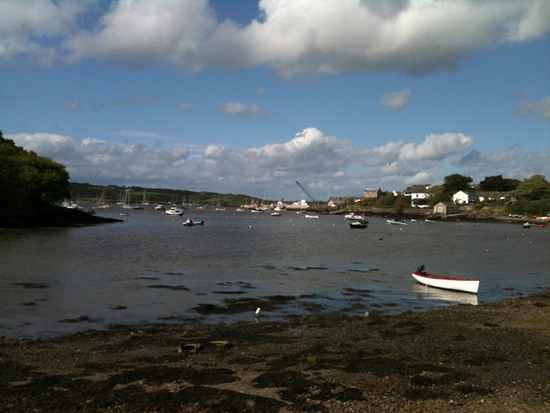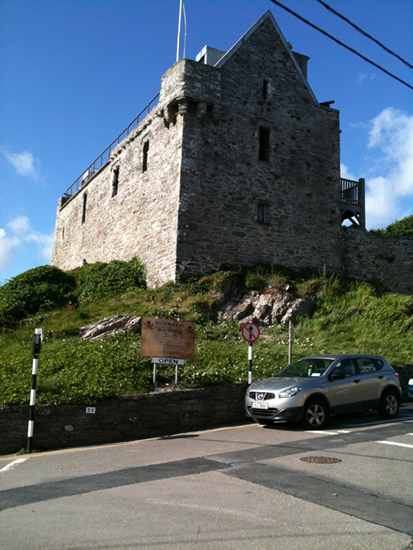Kinsale to Baltimore

|
Kinsale to Baltimore via Glandore Kinsale to Glandore was yet another motor as there was barely any wind. When it did come, it quickly veered round to the South West, so the sails, which had been set briefly, had to be furled again. We were able to pick up a mooring and dinghy ashore to explore. The village of Glandore is very small, but has at least three bars and eateries. We saw signs to the stone circle of Drombeg, which was only three kilometres away, so had a very pleasant walk there along stone walled lanes filled with wild flowers. There was a balmy south west wind, and the place had an almost Mediterranean feel about it. The stone circle itself was in much more forbidding surroundings, situated in wild moorland. It is a completely intact stone circle, about nine yards across, aligned NE SW so that the sun rises through the main portal at the winter solstice. Excavation work had been carried out about 50 years ago, and the charred bones of an adolescent boy were found in the centre of the circle. Rather spookily, you apparently quite often find the remains of more recent ceremonial activity here. A little distance away are the excavated remains of an iron age hut and cooking pit which brought a more domestic feel to the place.
Back on board, we picked up the latest weather forecast which talked of high winds coming in from the West. This was confirmed the next morning with a warning of gale force winds coming in over the next 24 hours, possibly from the South/ South West. Glandore is completely open to the South and would have been impossible in those conditions, so we decided to grab our chance and go straight round to Baltimore harbour, which although very shallow, is protected from winds from any direction. Unfortunately we had to by-pass Barlogue Bay which had come highly recommended. Apparently you anchor in the bay and then at ¾ tide, dinghy in to Loch Hyne through a narrow, tide scoured channel. The Loch is apparently very scenic. You then have to wait for the tide to turn before you shoot out again into the outer Bay. The timing was all wrong, and in any case, with a south west gale coming in, it would not have been a good place to be caught. This time we had a magnificent sail, albeit in the pouring rain. The wind was NE 6-7, blowing off shore, so we had a relatively flat sea, and we whizzed round to Baltimore in a couple of hours. There was considerable excitement at one point when John saw a huge fish jump from the water. It jumped again, and this time was seen by Chris as well , so it was recorded as a confirmed sighting! It was definitely not a dolphin but was big enough to be a tuna. Theo had read that there were albacores, a type of tuna, to be found along this coast, so maybe it was one of them. Needless to say, we are now trolling a line! Our arrival in Baltimore was pretty exciting. It is very shallow all over the bay and there are only a few anchorages, nearly all in shallow water. We managed to drop the anchor on a mud bank, and then anxiously watched the echo sounder as the tide dropped to a very low spring low. At 0.3 meters under the keel, we were ready to move the boat, even though the wind was now blowing at a constant force 6 or 7. Luckily the depth started increasing so we were able to stay put. The wind increased to a solid force 7, gusting force 8 and the rain remained torrential. Going ashore in the dinghy would have been positively suicidal, so we stayed put for the rest of the day and overnight. The next day John kept a close eye on the echo sounder again, even though low water was meant to be a bit higher than on the previous day. Alarmingly, with two hours to go to low water and 1.2 meters to drop, the depth beneath the keel was already showing only 1 meter. So despite the gale force winds, we decided that we had to move the boat somewhere safer. This was easier said than done with great gusts of wind blowing the boat sideways, making her strain at the anchor that we were trying to lift. We managed it in the end however, and found a slightly deeper anchorage further into the bay. Despite the howling winds and spume flecked water, we were thrilled to see an otter surface near us with a big silver fish in its mouth. It certainly wasn’t worried by the weather conditions. The wind started abating later in the afternoon, so the dinghy was launched into the still choppy waters, and we motored at a snail’s pace into the small harbour, shipping gallons of water as we went. We were drenched when we got there, and dried off by taking a walk up to the beacon situated at the mouth of the harbour. It is a real landmark, very prominent when coming in from the sea, and is nicknamed appropriately Lot’s Wife.
Baltimore is a very pretty fishing village, but has a rapacious approach to rubbish disposal from yachts. We arrived on shore with one bag of rubbish and were faced with a mechanised bin which required us to put in coins to the value of 6 euros before it would open its maw to accept our rubbish. Apart from not having the correct coinage, it seemed an awful lot to pay for a service that is provided for free everywhere else in the world. Getting increasingly irritated, we roamed the foreshore and the village looking for other places to deposit our waste. All the big wheely bins were firmly padlocked and John and Chris resorted to posting our rubbish piece by rather slimy piece into one of the town bins. They were also firmly locked down with a tiny slot left open for depositing waste. Having dealt with this, we repaired to the pub for a drink. On coming out, Chris swears that he saw a uniformed member of the ‘waste police’, inspecting the bin we had dumped our rubbish in. We had obviously been observed, and our only recourse was to dart back into the pub in order to avoid a serious fine. That was all well and good, quite welcome in fact, but Baltimore – come on – lighten up on the rubbish front! Back to the boat, through the still choppy waters. Dinner was a culinary triumph, with pork chops bought in Kinsale, cooked in Azorean flageolet beans left over from the Atlantic crossing, spiced up, on inspiration by Fernande, with some spicy Clonakilty black pudding. We are yet to eat ashore, a treat lined up for the weekend, but it will have to be good to come up to Suilven’s culinary standards. And so early to bed, and to a quiet night. Mercifully the wind dropped to nothing, so everyone was able to catch up on some much needed sleep. |





